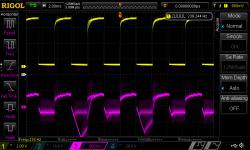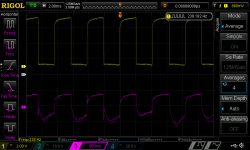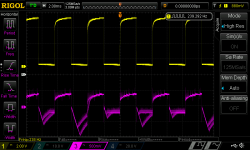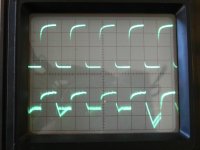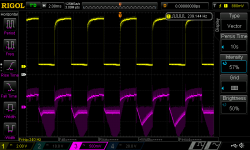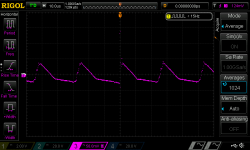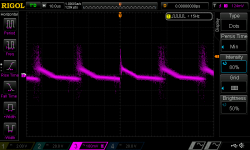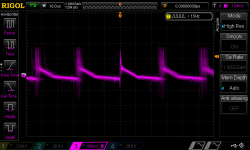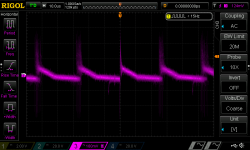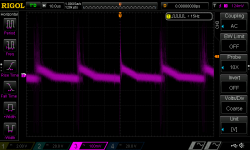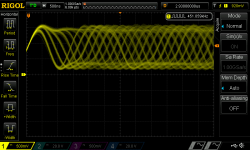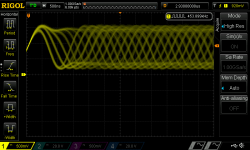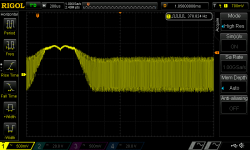Hi timpert,
Most of those tricks we do without even thinking about it. As for meters, I have a number of good DVMs, but I also keep some analogue meters around for the very reason you mentioned. I even have an HP 3581C selective voltmeter, a cool toy all on its own. Analogue meters are about the only sane way to observe a signal when tuning or adjusting it. Like traps on those older tape recorders for example.
I have a USB scope, just 8 bit though. I find them impossible to use for normal probing due to the computer interface using a mouse and keyboard. These are best used for jobs where you set them up for specific jobs. There is nothing like reaching out and twisting a knob for efficient probing.
-Chris
Most of those tricks we do without even thinking about it. As for meters, I have a number of good DVMs, but I also keep some analogue meters around for the very reason you mentioned. I even have an HP 3581C selective voltmeter, a cool toy all on its own. Analogue meters are about the only sane way to observe a signal when tuning or adjusting it. Like traps on those older tape recorders for example.
I have a USB scope, just 8 bit though. I find them impossible to use for normal probing due to the computer interface using a mouse and keyboard. These are best used for jobs where you set them up for specific jobs. There is nothing like reaching out and twisting a knob for efficient probing.
-Chris
Yesterday, I received the Rigol DS1074Z-S as promised.
After some quick checks that the scope was functioning properly, I applied the well documented hack. So now it's a DS1104Z-S with all functions (except the problematic high sensitivity option) enabled permanently.
Then I checked for the known trigger jitter issues with the DS1000 series (the "5 us trigger jitter" and the "AC trigger coupling jitter").
Mine didn't seem to suffer from them at all, even though it was still running the firmare version in which it had been solved yet.
Then I requested the latest firmware from Rigol and installed it.
To continue the discussion on this topic, I made a few captures of a test setup that I thought might be useful for comparison.
The setup is a cheap swith mode wall wart powering a PWM-controlled LED-strip.
This shows a couple of things: the switching noise, the reaction to the pulsed load and a lower frequency superimposed.
CH1 shows the PWM-output to the LED-strip and is used for triggering, CH2 shows the output ripple and noise of the wall wart.
First attachment shows the result in normal acquisition mode, the second averaged to 4 and the third in high res mode. And for comparison what my Philips PM 3208 shows.
This wall wart doesn't like it if the duty cycle of the PWM controller is set somewhere halfway. The light is visibly unsteady. Use a better adapter, and this issue is gone.
The last attachment shows how unstable the wall wart is at these duty cycles with a persistence set to 10 s (the other captures were taken at min. persistence).
Couldn't this be said for any digitising process, however fast?
After some quick checks that the scope was functioning properly, I applied the well documented hack. So now it's a DS1104Z-S with all functions (except the problematic high sensitivity option) enabled permanently.
Then I checked for the known trigger jitter issues with the DS1000 series (the "5 us trigger jitter" and the "AC trigger coupling jitter").
Mine didn't seem to suffer from them at all, even though it was still running the firmare version in which it had been solved yet.
Then I requested the latest firmware from Rigol and installed it.
With digital scopes that aren't the best, every capture is assumed valid. An analogue scope captures continuously with next to the equivalent of infinite samples. A DSO captures maybe 500 to 1000 sample points, the less expensive ones even less. Because random noise is captured by so few data points, it is weighted far too high and you end up with many data points that do not lie in a straight line.
To continue the discussion on this topic, I made a few captures of a test setup that I thought might be useful for comparison.
The setup is a cheap swith mode wall wart powering a PWM-controlled LED-strip.
This shows a couple of things: the switching noise, the reaction to the pulsed load and a lower frequency superimposed.
CH1 shows the PWM-output to the LED-strip and is used for triggering, CH2 shows the output ripple and noise of the wall wart.
Fuzzy in other words. By averaging with few samples you give noise less weight as a normal analogue scope would. This noise isn't valid data once you consider how many adjacent data points you are missing. That is why I suggested 4 averages instead of 32 or more.
First attachment shows the result in normal acquisition mode, the second averaged to 4 and the third in high res mode. And for comparison what my Philips PM 3208 shows.
This wall wart doesn't like it if the duty cycle of the PWM controller is set somewhere halfway. The light is visibly unsteady. Use a better adapter, and this issue is gone.
The last attachment shows how unstable the wall wart is at these duty cycles with a persistence set to 10 s (the other captures were taken at min. persistence).
DSOs are blind at various times.
Couldn't this be said for any digitising process, however fast?
Attachments
Last edited:
Hi jitter,
Yes, you can see how much more useful it is to average a low number of captures. This mode specifically will not show runt pulses of any other "one off" signals. But then, that is why you do averaging. This is closer to an analog display since our eyes do the averaging. This mode is great for showing waveform details that are consistent.
That is a great demonstration you picked. It's also a real world situation. Now you know more about the LED driver too!
I think your choice to show various averaging was excellent. It really shows how to use the features of your DSO to the best advantage. This little scope is even better than the last one I looked at - expected. Rigol is an excellent company. As for the trigger issue yours doesn't have, that was probably fixed in firmware or hardware. Another reason it doesn't pay to be on the "bleeding edge" with new product. The "feature patch" is an uncommon bonus - good for you! Mind, you probably killed the warranty. In all likelihood you won't need the coverage. Your variable persistence is something I wish my scope had. Its either on or off.
So jitter, how do you find using it? Things like changing probes or cables, and just general manual control? It might be a bit on the light side for one hand probe changing. I would expect this scope to be very easy to operate, given the company it keeps.
-Chris
Your analogue scope shot shows an error when I try to expand it.
Yes, you can see how much more useful it is to average a low number of captures. This mode specifically will not show runt pulses of any other "one off" signals. But then, that is why you do averaging. This is closer to an analog display since our eyes do the averaging. This mode is great for showing waveform details that are consistent.
That is a great demonstration you picked. It's also a real world situation. Now you know more about the LED driver too!
I think your choice to show various averaging was excellent. It really shows how to use the features of your DSO to the best advantage. This little scope is even better than the last one I looked at - expected. Rigol is an excellent company. As for the trigger issue yours doesn't have, that was probably fixed in firmware or hardware. Another reason it doesn't pay to be on the "bleeding edge" with new product. The "feature patch" is an uncommon bonus - good for you! Mind, you probably killed the warranty. In all likelihood you won't need the coverage. Your variable persistence is something I wish my scope had. Its either on or off.
Exactly for a time yet. That was the point. Although, some DSO products are much worse than others. It won't be long before Keysight has eliminated this "blind spot", if they haven't already. Their goal is to at least equal the experience with an analog product. They have cut this time by using more than one processor. One stuffs the data into memory while another executes the normal scope stuff. That also makes the oscilloscope very responsive to control inputs. I bet their top of the line scopes have eliminated the blind time, or will very soon. This might simply be a question of memory space coupled with more than two processors to handle capture, manipulation and user input. Most of the information I get is on their mid-range and low high-end products. They are close to eliminating the blind time in that market segment. Then it trickles down to the mid- lower end products. As you can see quite clearly, nothing wrong with low - end product these days! When my scope was sold, lower end product wasn't useful for anything more than the most basic uses. My, how times have changed!Couldn't this be said for any digitising process, however fast?
So jitter, how do you find using it? Things like changing probes or cables, and just general manual control? It might be a bit on the light side for one hand probe changing. I would expect this scope to be very easy to operate, given the company it keeps.
-Chris
Your analogue scope shot shows an error when I try to expand it.
Hello Chris,Hi JohnW,
Like you, I will always keep a couple analogue scopes around, and I do enough so that when I have one on the bench, I miss the other one. New bench will solve that problem.
For your lab, consider using power bars where you can. I have the same issue that you do, but not to that extent.
-Chris
since everyone is bragging about scopes, lets me join, hehe. I started with 20MHz Hitachi, than Tek 5000 but that did not work well, than had Tek 485 until its screen died, than got from friend digital Yokogawa... (loved that one) finally settled with LeCroy LT 584 1GHz. For LeCroy one really needs to learn well how to use it and to be familiar. I am planing to get Tek 22XX, for all benefits you mentioned about analog scope and for its simplicity.
Best
Howdy AR2,
Started with a 20 MHz, dual trace? Then into the Tektronix family? How was the 485 to work with? I'm curious because I have a 468 here that doesn't work and am thinking of restoring it.
Yokogawa is related to Agilent in some way I think. I am not surprised you liked that one. You don't see much of their stuff over here, unless you look at the rear panel of HP / Agilent products here and there. Generally pretty good stuff.
Your LeCroy sounds like another really good scope. They are different, but I didn't know they were that different. I have never borrowed one to work with. Anyway, that scope was pretty expensive, and I'll bet it can do some pretty whiz-bang stuff! How long have you had it now?
There are a lot of analogue scopes to choose from that are more than good enough. The Tek is okay, but so is the Gould and many others. Your LeCroy will handle the measurements, so the analogue scope is more for looking at waveform quality. A Philips has a really sharp trace. Another Yokogawa might make sense.
Now time for a chuckle. I just got an old B&K 2120 (20 MHz) scope running. It took three days and had problems in every circuit. When I started, the -2 KV tube supply measured over 4 KV! Some caps (film types) blew sections of their case off with a loud cracking. I didn't bother to attempt to read the actual voltage. It's -ve 12 V supply went positive also, just a complete mess. The trace was an entire division wide (1 cm!). Now it's happy, just waiting for a calibration. Someone messed with many trimmers, lovely. I think this one will become attached to a curve tracer. The two BNC inputs can be changed to banana jacks.
-Chris
Started with a 20 MHz, dual trace? Then into the Tektronix family? How was the 485 to work with? I'm curious because I have a 468 here that doesn't work and am thinking of restoring it.
Yokogawa is related to Agilent in some way I think. I am not surprised you liked that one. You don't see much of their stuff over here, unless you look at the rear panel of HP / Agilent products here and there. Generally pretty good stuff.
Your LeCroy sounds like another really good scope. They are different, but I didn't know they were that different. I have never borrowed one to work with. Anyway, that scope was pretty expensive, and I'll bet it can do some pretty whiz-bang stuff! How long have you had it now?
There are a lot of analogue scopes to choose from that are more than good enough. The Tek is okay, but so is the Gould and many others. Your LeCroy will handle the measurements, so the analogue scope is more for looking at waveform quality. A Philips has a really sharp trace. Another Yokogawa might make sense.
Now time for a chuckle. I just got an old B&K 2120 (20 MHz) scope running. It took three days and had problems in every circuit. When I started, the -2 KV tube supply measured over 4 KV! Some caps (film types) blew sections of their case off with a loud cracking. I didn't bother to attempt to read the actual voltage. It's -ve 12 V supply went positive also, just a complete mess. The trace was an entire division wide (1 cm!). Now it's happy, just waiting for a calibration. Someone messed with many trimmers, lovely. I think this one will become attached to a curve tracer. The two BNC inputs can be changed to banana jacks.
-Chris
Mind, you probably killed the warranty.
I doubt it. At least, here in the EU. There are two things that go against this: Rigol publishes its warranty conditions online, and they don't say that unlocking features will void the warranty. If there are additional conditions, they must be explicitly handed over to the customer before the purchase is made. Including a sheet with extra conditions in the box that says "stop unpacking, agree with these extra conditions or return the product" doesn't cut it over here.
Another issue is that the burden of proof for warranty denial (in case of a warranty claim with a hacked scope) lies with Rigol: they must show that the hack has caused the defect, if they want to deny the claim. A similar thing happened with jailbroken iPhones, where Apple used to deny warranty on jailbroken phones. But in the EU, the rules are such that Apple must honor the warranty claim, provided the jailbreak did not cause the defect. A vendor is not allowed to push the law aside in its sales conditions.
That will not stop the vendor from trying to deny the claim, and with the average hapless customer, they'll probably get away with it. But if the customer happens to be a little bit "law savvy", it might become a totally different story...
Their goal is to at least equal the experience with an analog product. They have cut this time by using more than one processor. One stuffs the data into memory while another executes the normal scope stuff. That also makes the oscilloscope very responsive to control inputs.
That goes on to show that things we take for granted in the analog world requires a substantial amount of data bandwidth and processing in the digital world. User interface (un)responsiveness is something that can make me crazy with certain digital devices, although I have never had that feeling with any analog or mechanical device. Only the latest devices seem to be successful in dealing with that. I still find real buttons and knobs a joy to use, compared to soft buttons and rotary encoders. But I find touch screens brilliant, provided it is coupled with a responsive and well designed user interface.
The future is digital, and the future models will indeed close the gap with analog ones. I get the feeling that we are now approaching the end of a transition period, in which there are still good reasons to keep an analog and a digital scope on the bench. But eventually, the analog scope will go the way of the film camera (don't say analog!) in most applications, because the small advantage that film offers over modern digital imaging is simply swamped by the advantages of competent and fast electronics and associated software support.
Hi timpert,
Interesting warranty conditions in Europe. I had to administer warranty policies over on this side of the pond for many years. Any interference by the customer is enough to invalidate a warranty claim. Mind you, it was up to my discretion to pass or block the repair. If a customer came in with a fault not caused by software games, I would normally pass it without mention. Same for a mechanical or electronic change, as long as the customer did nothing to cause the failure, I would typically pass the repair for warranty. Many around here do not look at the exact fault and probable cause when determining warranty status. We did get many that were TIMs (technician induced failures). Those went to customer pay immediately, except for the total loss units. We would report the serial number and reason to the distributor / manufacturer. That blocked the serial forever from warranty.
-Chris
Interesting warranty conditions in Europe. I had to administer warranty policies over on this side of the pond for many years. Any interference by the customer is enough to invalidate a warranty claim. Mind you, it was up to my discretion to pass or block the repair. If a customer came in with a fault not caused by software games, I would normally pass it without mention. Same for a mechanical or electronic change, as long as the customer did nothing to cause the failure, I would typically pass the repair for warranty. Many around here do not look at the exact fault and probable cause when determining warranty status. We did get many that were TIMs (technician induced failures). Those went to customer pay immediately, except for the total loss units. We would report the serial number and reason to the distributor / manufacturer. That blocked the serial forever from warranty.
-Chris
Hi timpert,
Yes, it does take a lot of circuitry and memory to fake normal controls and the "feel and function" of a piece of equipment. Consumer goods went digital pretty quickly, but there are examples of equipment that are reproducing that analog feel. Usually the more expensive units.
With test equipment, we use those instruments and need to operate them without having to think about what we are doing. They tried that with a few instruments, which didn't work out for sales numbers. Back to the analog feel we go.
I find optical encoders fine to deal with. It would be nice to feel that re-assuring stop of the rotation to know we reached the limit of control though. Most instruments with a PC based control panel are only good for automated control, or a preplanned set of procedures. Normally we are faced with reconfiguring instruments on the fly depending on how the testing goes. I did once set up a Tek 2467 to step through a set of configurations. That only worked because the tech only did one type of repair on specific equipment (DA-88 multitrack digital recorder from Tascam). I got him a stomp switch so he could easily step through the alignment procedure. Special case.
I do think that we will eventually end up with a user interface that is a blend of the two methods. Even early spectrum analyzers ended up being keypad driven for setup, and so will it be that scopes and signal sources head down a similar past.
I recently attended a Keysight seminar showing new products, and also techniques for taking measurements efficiently. While there, we were lucky to be allowed to use a new release, 3 weeks old. This new product was using the "standard user interface" that all new equipment would be using. It was more comfortable to use than earlier products and most of us really liked it. But this shows that manufacturers care very much for acceptance by making the operation make sense to the operator. When using an instrument designed to work with a human mind, you end up with fewer errors, reduced wasted time and general higher productivity. All we technicians know is that we like the instrument. Don't tell us that the changes improve our productivity!
I'm not worried about the future form of the user interface. We will both change to arrive at a middle ground that is easier to use. For sure, the user interface is going to require less input from us (autoset - yahoo!!) in order to do our jobs. Jitter's Rigol is proof enough of that (having played with one).
-Chris
Yes, it does take a lot of circuitry and memory to fake normal controls and the "feel and function" of a piece of equipment. Consumer goods went digital pretty quickly, but there are examples of equipment that are reproducing that analog feel. Usually the more expensive units.
With test equipment, we use those instruments and need to operate them without having to think about what we are doing. They tried that with a few instruments, which didn't work out for sales numbers. Back to the analog feel we go.
I find optical encoders fine to deal with. It would be nice to feel that re-assuring stop of the rotation to know we reached the limit of control though. Most instruments with a PC based control panel are only good for automated control, or a preplanned set of procedures. Normally we are faced with reconfiguring instruments on the fly depending on how the testing goes. I did once set up a Tek 2467 to step through a set of configurations. That only worked because the tech only did one type of repair on specific equipment (DA-88 multitrack digital recorder from Tascam). I got him a stomp switch so he could easily step through the alignment procedure. Special case.
I do think that we will eventually end up with a user interface that is a blend of the two methods. Even early spectrum analyzers ended up being keypad driven for setup, and so will it be that scopes and signal sources head down a similar past.
I recently attended a Keysight seminar showing new products, and also techniques for taking measurements efficiently. While there, we were lucky to be allowed to use a new release, 3 weeks old. This new product was using the "standard user interface" that all new equipment would be using. It was more comfortable to use than earlier products and most of us really liked it. But this shows that manufacturers care very much for acceptance by making the operation make sense to the operator. When using an instrument designed to work with a human mind, you end up with fewer errors, reduced wasted time and general higher productivity. All we technicians know is that we like the instrument. Don't tell us that the changes improve our productivity!
I'm not worried about the future form of the user interface. We will both change to arrive at a middle ground that is easier to use. For sure, the user interface is going to require less input from us (autoset - yahoo!!) in order to do our jobs. Jitter's Rigol is proof enough of that (having played with one).
-Chris
Hi jitter,
Yes, you can see how much more useful it is to average a low number of captures. This mode specifically will not show runt pulses of any other "one off" signals. But then, that is why you do averaging. This is closer to an analog display since our eyes do the averaging. This mode is great for showing waveform details that are consistent.
That is a great demonstration you picked. It's also a real world situation. Now you know more about the LED driver too!
I think your choice to show various averaging was excellent. It really shows how to use the features of your DSO to the best advantage. This little scope is even better than the last one I looked at - expected. Rigol is an excellent company.
It's unfortunate that you weren't able to expand the photo of the analogue scope. Here's a link that should work. It shows that the litle pulses riding on top of the wall wart output are also picked up by the analogue scope. In this case I would say that the averaged trace on the DSO is looking cleaner than it really is. The high res mode seems to come closest to what the analogue scope would show.
If I run the LED-strip at full output, there's only the noise from the switch mode wall wart. I tried a few more things on the DSO with acquisition and display settings.
First attachment is the noise in normal acq. mode, quite a fat trace, so I switched in the 20 MHz bandwidth limit which yielded the second attachment.
Third attachment shows the thinner trace in the high res setting.
The fourth attachment is with display in dot mode instead of vector mode. This really shows how jittery the switching noise of the wall wart is.
The last attachment is with a high number average to show how much that has an effect on the result. Quite a lot, but note the dots in the third division above the centre. Only based on the normal acq. mode would I have expected anything there. But that does explain why moving the trigger level way above the visible signal didn't result in losing the trigger. Perhaps I should have turned up trace intensity to see that.
As for the trigger issue yours doesn't have, that was probably fixed in firmware or hardware.
Or perhaps mine is a little older. It did have the same firmware and hardware revisions as the troubled units from the first video.
The problems were reported from a certain date onwards. What I understand from the second video (from 10:06) is that it has something to do with the PLL-circuit and that Rigol has tweaked the PLL-coefficients. This solved the problem (from 15:40), for most but not all units (apparently the fix actually made it worse for some people).
On mine the problem is luckily absent, with both the factory and the latest version firmware.
Mind, you probably killed the warranty. In all likelihood you won't need the coverage.
To be honest, I hadn't really though that through at all. I figured if I didn't break the warranty seal, I was OK. Glad to read what timpert wrote about EU regulations.
So jitter, how do you find using it? Things like changing probes or cables, and just general manual control? It might be a bit on the light side for one hand probe changing. I would expect this scope to be very easy to operate, given the company it keeps.
I was away from home this weekend, so I haven't had time to use it extensively. But I already found that this little scope has a nice, intuitive interface that you can operate without reading the manual.
For the size, it's actually not that light, I weighed it at 3.1 kg (~6.8 lb). It also feels quite sturdy. The probes that come with the scope have rather hard to grip BNCs, but one hand changing was just possible, though.
The single biggest annoyance is the loud fan.
-Chris
Your analogue scope shot shows an error when I try to expand it.
Hmm, at home and at work I have no problems expanding them (both running Chrome), so I wouldn't know why it doesn't work for you and what I can do to avoid it in the future...
Attachments
Last edited:
I should have mentioned one thing: I assumed Jitter has bought his oscilloscope as an individual, which means that he enjoys the normal consumer protection. If he had bought his scope for a company, things become a bit different. But still, also for companies, all conditions must be on the table before the deal is closed. Jack-in-the-box conditions are not allowed.
There are many other ways to nag clandestine upgraders though. For example, hack upgrading the scope can be seen as software piracy. I don't know how that is dealt with though.
There are many other ways to nag clandestine upgraders though. For example, hack upgrading the scope can be seen as software piracy. I don't know how that is dealt with though.
Hi jitter,
Chrome works it seems. Firefox is getting testy, or is it NoScript? Either way, nice shot. All the other pictures opened fine in Firefox - go figure.
The shots you posted this time show me just how close the Rigol is to a Keysight model. I am more impressed. Good call on buying that one!
Most of what will keep you out of trouble with a digital scope is knowing how to manipulate the acquisition modes in order to bring out the real detail. Oh, did you notice that your waveform is centered in mid-screen? That's why the details get blurry on each side. You should be able to shift the mid point focus to the left side as it it was an analogue scope. To observe things like an eye pattern you will have to do that. Now there is the acid test, try to look at an eye pattern from a CD player.
I saw an analogue scope aliasing today. It turned out to be the chopper for the two channels. Colour me surprised, that's a new one! Its got to be something with how B&K triggers that will allow double triggers or something. It was pretty weird to see.
-Chris
Chrome works it seems. Firefox is getting testy, or is it NoScript? Either way, nice shot. All the other pictures opened fine in Firefox - go figure.
The shots you posted this time show me just how close the Rigol is to a Keysight model. I am more impressed. Good call on buying that one!
Most of what will keep you out of trouble with a digital scope is knowing how to manipulate the acquisition modes in order to bring out the real detail. Oh, did you notice that your waveform is centered in mid-screen? That's why the details get blurry on each side. You should be able to shift the mid point focus to the left side as it it was an analogue scope. To observe things like an eye pattern you will have to do that. Now there is the acid test, try to look at an eye pattern from a CD player.
I saw an analogue scope aliasing today. It turned out to be the chopper for the two channels. Colour me surprised, that's a new one! Its got to be something with how B&K triggers that will allow double triggers or something. It was pretty weird to see.
-Chris
Hi timpert,
You know what? If jitter's scope is anything like the HP / Agilent products I have come to know, he will not be seeing the warranty on this instrument. No need, given how it is put together. My 54642D is also deceptively heavier than its size and plastic case would suggest.
I suspect that the software angle you mentioned would be the thing to worry about. I have no idea how that might play out.
-Chris
You know what? If jitter's scope is anything like the HP / Agilent products I have come to know, he will not be seeing the warranty on this instrument. No need, given how it is put together. My 54642D is also deceptively heavier than its size and plastic case would suggest.
I suspect that the software angle you mentioned would be the thing to worry about. I have no idea how that might play out.
-Chris
I do not think that individuals need to worry, only corporate users.
Someone at the EEVblog mentioned that the ease of hacking may be deliberate, to allow students and home users to become familiar with the Rigol products and features at school and at home, and then take the recommendation to work. But it is just a theory, nobody has had a look in the boardroom when the security of the firmware was discussed...
But a hint of this policy can be seen at the product page for the DS1000E and DS1000Z series on rigolna.com:
DS1000E Series Digital Oscilloscopes | Rigol - Beyond Measure
and
DS1000Z Series Digital Oscilloscopes | Rigol - Beyond Measure
Lower left of the page, "user and partner videos". A few clicks to the right, and you'll find a video about hacking the scope
Someone at the EEVblog mentioned that the ease of hacking may be deliberate, to allow students and home users to become familiar with the Rigol products and features at school and at home, and then take the recommendation to work. But it is just a theory, nobody has had a look in the boardroom when the security of the firmware was discussed...
But a hint of this policy can be seen at the product page for the DS1000E and DS1000Z series on rigolna.com:
DS1000E Series Digital Oscilloscopes | Rigol - Beyond Measure
and
DS1000Z Series Digital Oscilloscopes | Rigol - Beyond Measure
Lower left of the page, "user and partner videos". A few clicks to the right, and you'll find a video about hacking the scope
Hi anatech,
Thanks. I'm grateful for the internet which made choosing the right scope a lot easier. The combination "good" and "affordable" kept turning up the name Rigol, with the DS1000Z series in particular.
I also considered a similarly priced Owon, but reviews of that one weren't nearly as favourable.
Good idea. I still have my Nakamichi CD-4 that I just brought down from the attic. It still works. The first attachment shows the eye pattern in normal acquisistion mode, the second in high res mode.
I also tried to trigger the HF-RF depression using a special test-CD, and it took some fiddling with the knobs, but it works.
What both look like on the Philips scope can be found in this post from 2008.
I'm curious what that looks like. Do you have a picture?
The shots you posted this time show me just how close the Rigol is to a Keysight model. I am more impressed. Good call on buying that one!
Thanks. I'm grateful for the internet which made choosing the right scope a lot easier. The combination "good" and "affordable" kept turning up the name Rigol, with the DS1000Z series in particular.
I also considered a similarly priced Owon, but reviews of that one weren't nearly as favourable.
Most of what will keep you out of trouble with a digital scope is knowing how to manipulate the acquisition modes in order to bring out the real detail. Oh, did you notice that your waveform is centered in mid-screen? That's why the details get blurry on each side. You should be able to shift the mid point focus to the left side as it it was an analogue scope. To observe things like an eye pattern you will have to do that. Now there is the acid test, try to look at an eye pattern from a CD player.
Good idea. I still have my Nakamichi CD-4 that I just brought down from the attic. It still works. The first attachment shows the eye pattern in normal acquisistion mode, the second in high res mode.
I also tried to trigger the HF-RF depression using a special test-CD, and it took some fiddling with the knobs, but it works.
What both look like on the Philips scope can be found in this post from 2008.
I saw an analogue scope aliasing today. It turned out to be the chopper for the two channels. Colour me surprised, that's a new one! Its got to be something with how B&K triggers that will allow double triggers or something. It was pretty weird to see.
I'm curious what that looks like. Do you have a picture?
Attachments
I do not think that individuals need to worry, only corporate users.
Someone at the EEVblog mentioned that the ease of hacking may be deliberate, to allow students and home users to become familiar with the Rigol products and features at school and at home, and then take the recommendation to work. But it is just a theory, nobody has had a look in the boardroom when the security of the firmware was discussed...
But a hint of this policy can be seen at the product page for the DS1000E and DS1000Z series on rigolna.com:
DS1000E Series Digital Oscilloscopes | Rigol - Beyond Measure
and
DS1000Z Series Digital Oscilloscopes | Rigol - Beyond Measure
Lower left of the page, "user and partner videos". A few clicks to the right, and you'll find a video about hacking the scope
I heard that theory in another video as well, but I doubt that was done deliberately. I guess if they wanted to, they could change the firmware to make hacking a lot more difficult.
But hey, would you rather sell a bucket load of your cheapest model (as they seem to do) that get hacked than a lot less that don't get hacked?
Hi jitter,
That is a wonderful scope you have there! Those eye patterns are Agilent quality. I would be happy using the scope you got for service. The envelope looks good too. Zero complaints from me!
There we go. Finally DSO quality at a price many of us can afford. I have to say that I am very happy for you jitter.
-Chris
That is a wonderful scope you have there! Those eye patterns are Agilent quality. I would be happy using the scope you got for service. The envelope looks good too. Zero complaints from me!
There we go. Finally DSO quality at a price many of us can afford. I have to say that I am very happy for you jitter.
-Chris
@timpert:
Yes, reaction is quick, almost all of the time. I do notice a small lag when changing the vertical and horizontal scales in XY-mode, though.
@anatech:
Yes, I'm happy with it. Even compared to the much more expensive Agilent DSO3054A I use at work, I definitely don't feel shortchanged by the Rigol whatsoever, not at this kind of money.
It's no wonder that the €359/$399 DS1054Z is in such high demand that people have to wait. Basically, the DS1054Z is a software crippled DS1104Z that's a bit over half the price, but with the potential to be unlocked by the brave .
.
I wrote in an earlier post that I thanked the internet for finding the Rigol, but more specifically, credit has to go to the EEVblog for making me aware of its existence and qualities.
Yes, reaction is quick, almost all of the time. I do notice a small lag when changing the vertical and horizontal scales in XY-mode, though.
@anatech:
Yes, I'm happy with it. Even compared to the much more expensive Agilent DSO3054A I use at work, I definitely don't feel shortchanged by the Rigol whatsoever, not at this kind of money.
It's no wonder that the €359/$399 DS1054Z is in such high demand that people have to wait. Basically, the DS1054Z is a software crippled DS1104Z that's a bit over half the price, but with the potential to be unlocked by the brave
I wrote in an earlier post that I thanked the internet for finding the Rigol, but more specifically, credit has to go to the EEVblog for making me aware of its existence and qualities.
Last edited:
- Status
- This old topic is closed. If you want to reopen this topic, contact a moderator using the "Report Post" button.
- Home
- Design & Build
- Equipment & Tools
- Oscilloscope woes
